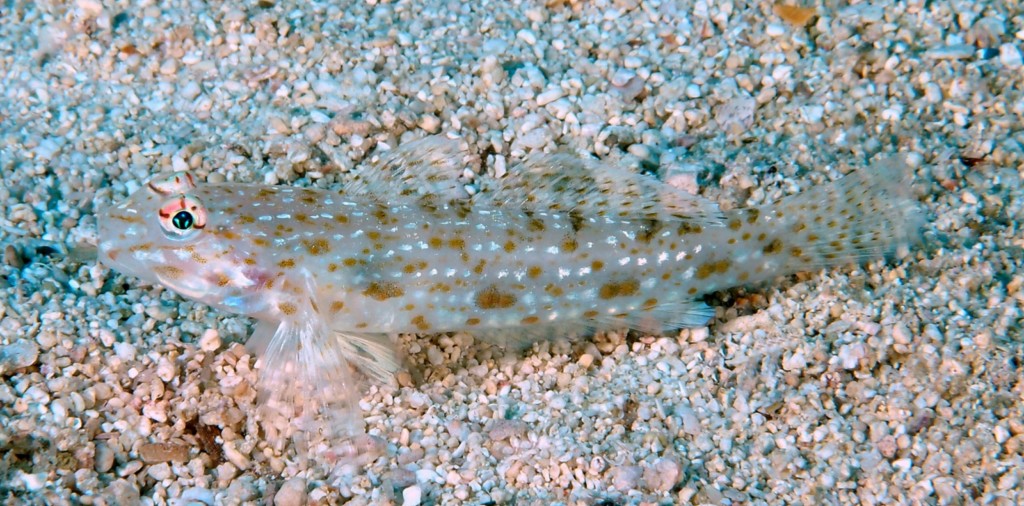ISTIGOBIUS RIGILIUS - (HERE, 1953)
Actinopterygii (Gigaclass) > Actinopteri (Class) > Teleostei (Subclass) > Gobiiformes (Order) > Gobioidei (Suborder) > Gobiidae (Family) > Gobiinae (Subfamily) > Istigobius (Genus)
Brown-speckled sand-goby, Brown-speckled Sandgoby, Orange-spotted goby, Orangespotted sandgoby, Rigilius goby, Madara-kazarihaze, マダラカザリハゼ, 線斑銜鰕虎, 線斑銜鰕虎魚,
Synonymes
Bikinigobius welanderi (Herre, 1953)
Istigobius rigillius (Herre, 1953)
Pallidogobius rigilius (Herre, 1953)
--------------------------
Description
Dorsal spines (total): 7, 4th spine of 1st dorsal fin longest; Dorsal soft rays (total): 10-11; Anal spine: 1; Anal soft rays: 9-10; Pectoral fin rays: 17-19; Upper pectoral fin rays entire. Predorsal scales 7-9, reaching interorbital space; Trunk with ctenoid scales; Absence of scales on cheek or opercle; Segmented and non branching caudal rays: 4, branching: 13. Longitudinal scale series: 29-32; Fully united pelvic fins with well-developed frenum; Body depth: 4.7-6.1 in SL. Max. length: 10.8 cm TL. Depth range: 0 - 30 m.
Color
Body yellowish white; To brown diagonal lines from preoperculum to upper jaw, connected by a single line; Two almost vertical brown lines on operculum. Males sometimes with 3-4 dusky vertical bars on abdomen.
Etymology
Istigobius: from Greek, istios = sail + from Latin, Gobius = a genus name of gobiine fish. Proposed as a subgenus of Gobius, referring to “larger scales, and longer caudal peduncle” of Istigobius stephensoni (now: Istigobius ornatus) compared to “true Palearctic” Gobius.
rigilius: from Rigili Island, Eniwetok Atoll, Marshall Islands, type locality.
Original description: Pallidogobius rigilius Herre, 1953 - Type locality: Rigili Island, Eniwetok Atoll, Marshall Islands.
Distribution
Southeastern Indian Ocean and western Pacific: Indonesia, east to Marshall Islands and Fiji, north to Ryukyu Islands (Japan), Philippines, south to northern Australia and New Caledonia.
Biology
Solitary. Occurs in sandy areas with living corals and coral rubble in clear waters. Genital papilla of male terminating to side of anal spine. Papilla of female truncate and terminating posteriorly well before origin of anal fin.
Similar species
Fusigobius neophytus (Günther, 1877) - Reported from New Caledonia - Link to the species (here).
Istigobius decoratus (Herre, 1927) - Reported from New Caledonia - Link to the species (here).
Istigobius goldmanni (Bleeker, 1852) - Reported from New Caledonia - Link to the species (here).
Istigobius hoesei (Murdy & McEachran, 1982) - Reported from Southwestern Pacific: New South Wales (Australia).
Macrodontogobius wilburi (Herre, 1936) - Reported from New Caledonia - Link to the species (here).
Last update: 7, October 2024
Brown-speckled sand-goby, Brown-speckled Sandgoby, Orange-spotted goby, Orangespotted sandgoby, Rigilius goby, Madara-kazarihaze, マダラカザリハゼ, 線斑銜鰕虎, 線斑銜鰕虎魚,
Synonymes
Bikinigobius welanderi (Herre, 1953)
Istigobius rigillius (Herre, 1953)
Pallidogobius rigilius (Herre, 1953)
--------------------------
Description
Dorsal spines (total): 7, 4th spine of 1st dorsal fin longest; Dorsal soft rays (total): 10-11; Anal spine: 1; Anal soft rays: 9-10; Pectoral fin rays: 17-19; Upper pectoral fin rays entire. Predorsal scales 7-9, reaching interorbital space; Trunk with ctenoid scales; Absence of scales on cheek or opercle; Segmented and non branching caudal rays: 4, branching: 13. Longitudinal scale series: 29-32; Fully united pelvic fins with well-developed frenum; Body depth: 4.7-6.1 in SL. Max. length: 10.8 cm TL. Depth range: 0 - 30 m.
Color
Body yellowish white; To brown diagonal lines from preoperculum to upper jaw, connected by a single line; Two almost vertical brown lines on operculum. Males sometimes with 3-4 dusky vertical bars on abdomen.
Etymology
Istigobius: from Greek, istios = sail + from Latin, Gobius = a genus name of gobiine fish. Proposed as a subgenus of Gobius, referring to “larger scales, and longer caudal peduncle” of Istigobius stephensoni (now: Istigobius ornatus) compared to “true Palearctic” Gobius.
rigilius: from Rigili Island, Eniwetok Atoll, Marshall Islands, type locality.
Original description: Pallidogobius rigilius Herre, 1953 - Type locality: Rigili Island, Eniwetok Atoll, Marshall Islands.
Distribution
Southeastern Indian Ocean and western Pacific: Indonesia, east to Marshall Islands and Fiji, north to Ryukyu Islands (Japan), Philippines, south to northern Australia and New Caledonia.
Biology
Solitary. Occurs in sandy areas with living corals and coral rubble in clear waters. Genital papilla of male terminating to side of anal spine. Papilla of female truncate and terminating posteriorly well before origin of anal fin.
Similar species
Fusigobius neophytus (Günther, 1877) - Reported from New Caledonia - Link to the species (here).
Istigobius decoratus (Herre, 1927) - Reported from New Caledonia - Link to the species (here).
Istigobius goldmanni (Bleeker, 1852) - Reported from New Caledonia - Link to the species (here).
Istigobius hoesei (Murdy & McEachran, 1982) - Reported from Southwestern Pacific: New South Wales (Australia).
Macrodontogobius wilburi (Herre, 1936) - Reported from New Caledonia - Link to the species (here).
Last update: 7, October 2024
